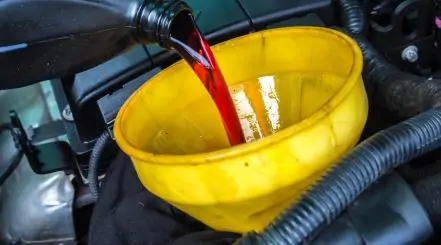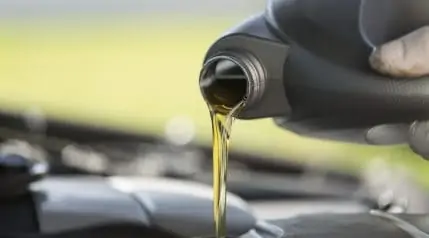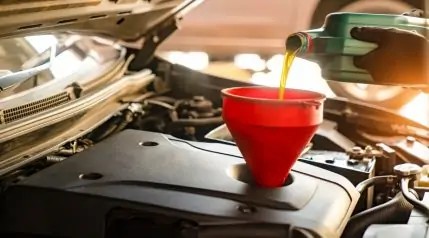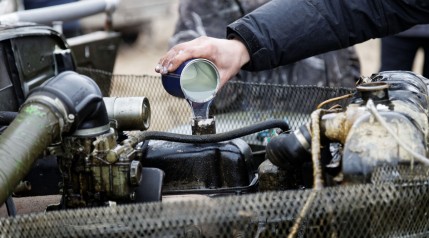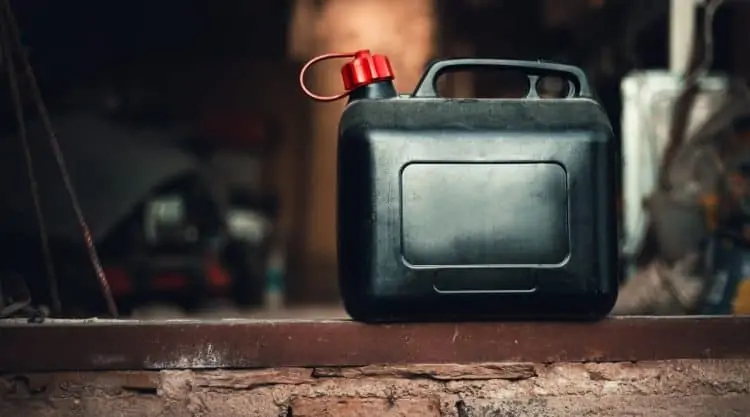
Every type of gas, no matter how fancy or pricey, has an expiration date. When that time comes, using it could have serious and ugly repercussions for the health of your vehicle. But what do you do with that old gasoline when it reaches its time to be put to pasture?
You’re about to discover how to identify the signs of aging, when it’s possible to reuse it or try additives, and when it’s ready to be thrown away.
You’ll also get familiar with how and when it’s possible to use mixed-age fuel together and learn how to safely dispose of any old gasoline you have laying around.
Contents (Jump to Topic)
- 1 Key Takeaways
- 2 Why Would You Need to Throw Away Old Gas?
- 3 Dangers of Disposing of Old Gas Irresponsibly
- 4 Can It Be Restored With Additives?
- 5 How to Visually Check for Old Gas and Contaminants
- 6 Is Mixing New and Used Gas an Option?
- 7 How to Use Old Gas Mixed With New
- 8 How to Dispose of Old Gas If It’s Unusable
- 9 Conclusion
Key Takeaways
Be Responsible – Never flush old gasoline down drains or your toilet. Just one gallon of the stuff can contaminate a million gallons of water.
Find a Government-Approved Disposal Center – There’s usually at least one of these in each municipality.
Get the Gear – Be sure to wear protective glasses, gloves, and a mask when handling bad (or even good) gas.
Why Would You Need to Throw Away Old Gas?
As we’ve briefly touched on, gasoline goes bad over time. Some of you may find yourselves questioning the obvious. Isn’t this substance derived from crude oil, a fossil fuel? How can it go bad after having remained intact for millions of years?
In fact, the petroleum products we use to power our vehicles, equipment, and tools are entirely different from crude oil. They’re refined and altered with other compounds. The end results have little to do with the fossil fuel they were derived from.
One of the products commonly added to our fuel is the alcohol compound called ethanol. This is because it reduces toxic emissions from engines that are powered by liquid petroleum.
Unfortunately, it can separate over time. When it does, this alcohol is no longer beneficial. It can be corrosive, which is bad news for your car’s internal mechanisms.
Degradation can also cause gummy deposits to form. If you try to use this unstable fluid, you could end up with a clogged and damaged engine.
Even if the gasoline hasn’t separated or degraded to this extent, it still won’t function as it should. The older it gets, the less combustible it is. This can lead to lowered engine performance.
If it’s beyond the point of saving, it has to be thrown away. There’s no point keeping a flammable substance around that you know you’ll never use. Additionally, the container you’re keeping it in will age over time. Why run the risk of endangering yourself or your family with leaks or fumes?
As we’ll explain below, any disposal has to be done in a responsible manner.
Dangers of Disposing of Old Gas Irresponsibly
You’re probably aware that petroleum products aren’t great for the environment. All of these motors running off fossil fuels produce harmful emissions.
Dumping gasoline irresponsibly can have similar adverse effects. The type we use in our cars can contain up to 150 chemicals, including benzene and lead.
It doesn’t dissolve easily in water. Keep this in mind if you were thinking about flushing it down your toilet or into a storm drain.
If you toss old gas outside (or fresh gas, for that matter), it can stay in the soil for a long time. Any wildlife that comes into contact with spilled gasoline or accidentally ingests it can end up sick or worse.
You also can’t just leave the entire gas container in a dumpster or garbage. This is a potentially dangerous move. Remember, it’s a highly flammable liquid we’re talking about. Accidents can happen – like a lit cigarette butt, for example.
Can It Be Restored With Additives?
Before we explain how to properly dispose of old gas, let’s take a look at the possibility of restoration with a fuel additive.
There’s a chance you may be able to salvage your older fuel with additives. You’ll learn what these chemicals are and if they might work for your situation.
What Are Additives?
Additives are useful compounds found in a range of automotive products, to enhance their performance. Just a few examples include the best car paint sealants, motor oils, and antifreeze.
What Can Fuel Additives Do?
They work to enrich the fuel by several means. This may include octane boosters, improving lubrication, and fighting corrosion and sediment buildup.
Certain additives, known as stabilizers, can extend the lifespan if they’re added when the gasoline is new. These can include ingredients such as methanol which encourages smoother combustion.
Some fuel additives are even capable of restoring old gas that has already begun to degrade. These are the ones that interest us at the moment.
It’s worth noting that many manufacturers keep the exact formula of their fuel stabilizer or additives secret. This is to avoid copycat products and limit their competition.
When Should Additives Be Used?
Ideally, you should use fuel stabilizers on fresh gas. The older it gets, the less likely a stabilizer is to be effective, so you want to use them while the fuel is fresh.
You can check out our guide to the best fuel stabilizers for how they work and some top recommended products
How Old Is Too Old?
New gas is rated to last for about half a year in an airtight container. Diesel can last a little longer: up to 12 months, depending on the ambient temperature. Exposure to heat, humidity, and the metal in your gas tank can shorten this estimate.
We’ll cover how to check for signs of aging and what they mean in the section below. In general, once the fluid is rancid you may not want to risk it. Even if you put in additives (or stabilizers), you’re still running a risk. If your chosen product doesn’t work, you could end up with engine damage.
Note that there are products that claim to rejuvenate years-old gasoline. If you read the reviews and find that users have had success with it, you can give it a try. Our best advice is to avoid these products or to at least proceed with extreme caution. They might not power your engine as well as you’d like them to and may even clog your fuel lines.
How to Visually Check for Old Gas and Contaminants
You can perform a quick visual inspection to see if your gasoline has gone bad. For extra assurance, you can buy some fresh and compare the two. Make sure the new product is the same brand and grade as the one you already have.
To identify bad gasoline or contaminated gas, all you’ll need is two clear cups or glasses. You can use plastic if you’re wary of reusing them when finished with your comparison. Simply pour a little of each into two containers, and compare how they look.
Fresh
When fresh, gasoline should be relatively clear and liquid in consistency. You’ll smell the characteristic sharp odor you know from trips to gas stations or auto repair shops.
Depending on the type, it can be light brown, yellow, or clear. In some cases, they’re dyed a particular color to identify them—e.g., for export.
Old But Salvageable
The old product’s color will probably be darker than the fresh. It may also have a sour smell to it. However, as long as it’s still liquid, it may be salvageable with the help of additives. This usually applies to fuel that has been stored for six months or less.
Ready for Disposal
Darkened, sour-smelling fluid with particles floating in it is usually done for.
If you see that the fluid has thickened or has visible deposits, consider it out of service. The same is true of ethanol-based brands that have separated.
Is Mixing New and Used Gas an Option?
In some cases, it may be possible to mix new and used together. You can try this on small motors – for example, lawn mowers or power tools that you haven’t used for a few months.
Keep in mind this is only possible if the fuel is salvageable. Don’t expect results if the gas has been sitting in the tank for more than a year. You’ll also have to use additives on the older fuel for best results.
Mixing old and new will help you to avoid draining your tank and save on fuel. At the same time, you should know that there are potential disadvantages. Your engine may not run, meaning you’ll have to drain the tank anyway.
The worst-case scenario is irreparable damage to your fuel system. This will happen if you’ve overestimated the quality of the older gas in your vehicle or equipment, and it’s full of deposits or changed into a gummy sludge.
Pros
- Avoid draining the tank.
- Salvage old fuel.
Cons
- Risk of the engine not starting.
- Could result in damage to your car engine.
How to Use Old Gas Mixed With New
If mixing used gasoline with new sounds appealing to you, we’ll guide you through the process.
Determine the Condition
We’ve mentioned this more than once for a good reason. Mixing is unwise if the old gas has separated or has visible particles inside it.
If it’s been more than six months, we recommend starting afresh. This is particularly true if you didn’t use a stabilizer before storage.
Proportions
You should aim to add between four and five parts of new product to one part old. The aim is to dilute the old liquid as much as possible.
You might also want to filter the old fluid to remove as many small particles as possible. This can be done using a cloth, or possibly a sieve or coffee filter, to strain it.
Automotive Use: Cars and Trucks
Don’t forget the hazards of running bad gas through your engine. The motor on a power tool may be easy to replace, but your vehicle’s engine is not.
If your car has been sitting with gas in the tank for several months or less, you can attempt mixing new with old. Again, you’ll likely have more success if you stabilized the fuel before adding it to your stored vehicle’s engine.
It’s worth repeating that the best option is to drain your tank of older, non-stabilized fluid. Better safe than sorry – you don’t want to pay for a costly visit to your mechanic.
Powering Small Equipment
As with passenger vehicles, you’re better off working with stabilized fuel. If it isn’t stabilized, the gas shouldn’t be more than a few months old.
Use additives and dilute the old fuel significantly. If you notice the engine on your chainsaw or lawn mower is having trouble, the gas most likely wasn’t viable.
How to Dispose of Old Gas If It’s Unusable
If your old gas isn’t reusable, (proper) disposal is the only choice you have left. Whether you have a small quantity or several cans worth, the same rules apply. You have to get rid of the gasoline safely and responsibly.
You should never pour gasoline down your drain or storm drains, or flush it down the toilet. Wastewater treatment plants aren’t equipped to handle it. Gasoline is a hazardous waste and just a gallon of normal gasoline can contaminate a million gallons of water…yikes!
Safety First
It’s essential to protect yourself when handling gasoline during the disposal process. Wear gloves, a mask, and safety glasses while you’re handling the fluid. If you have to switch containers, aim to do so in a well-ventilated area.
If you happen to spill gas onto your skin or into your eyes, act quickly. Rinse or splash your eyes with water for five or six minutes, making sure you keep your eyes open. If you get gas on your skin, wash it off with warm water and soap. If your skin becomes irritated, seek medical attention.
Find an Approved Disposal or Recycling Center
Check online for government-approved disposal or recycling centers or a hazardous waste disposal site near you. Research to make sure you can dispose of gasoline there before you make the journey to save time and effort. Each state or county has its own list of approved sites. If in doubt, check with your local fire department.
Transfer Fuel to Approved Container
If you’re draining a tank, the first step to take to safely dispose of old gas is to buy an approved, government-certified container. Those of you with older or damaged containers of stored fuel will have to do the same.
You’ll have to check with your local disposal center for guidelines before you do this. They may tell you that the container should be made of certain material or purchased from a specific place. Any disposal container should be durable—both for safety and convenience. After all, you could be disposing of fuel again at some point.
Note that you might also have to filter the gas through a cloth or a coffee filter prior to disposal. Again, follow all of the guidelines of your locality.
Safely Transport to Fuel Center
Drive (or walk) over to the local hazardous waste disposal center. Make sure you clarify to the staff that you want to keep your container.
When you arrive, simply allow them to take your containers, they will empty them out and return your containers to you. Or, if it’s a sort of ‘self-service disposal’, follow the instructions you’re given.
While you’re transporting gas, store it upright in a spot where it won’t topple over, drive carefully, and – it should go without saying – do not smoke in your vehicle.
Conclusion
Hopefully, you’re now comfortable with the ins and outs of how to dispose of old gas. Most of us will have to deal with this chore at some point in our lives, so it’s important to know how to do so without hurting the environment (or ourselves!).
Prevention is the best strategy when it comes to storing gasoline. Add stabilizing additives after purchase and aim to use the gas within a few months.
Do you have any questions for us? Please feel free to ask in the comments. We’ll make sure to answer every last one.

